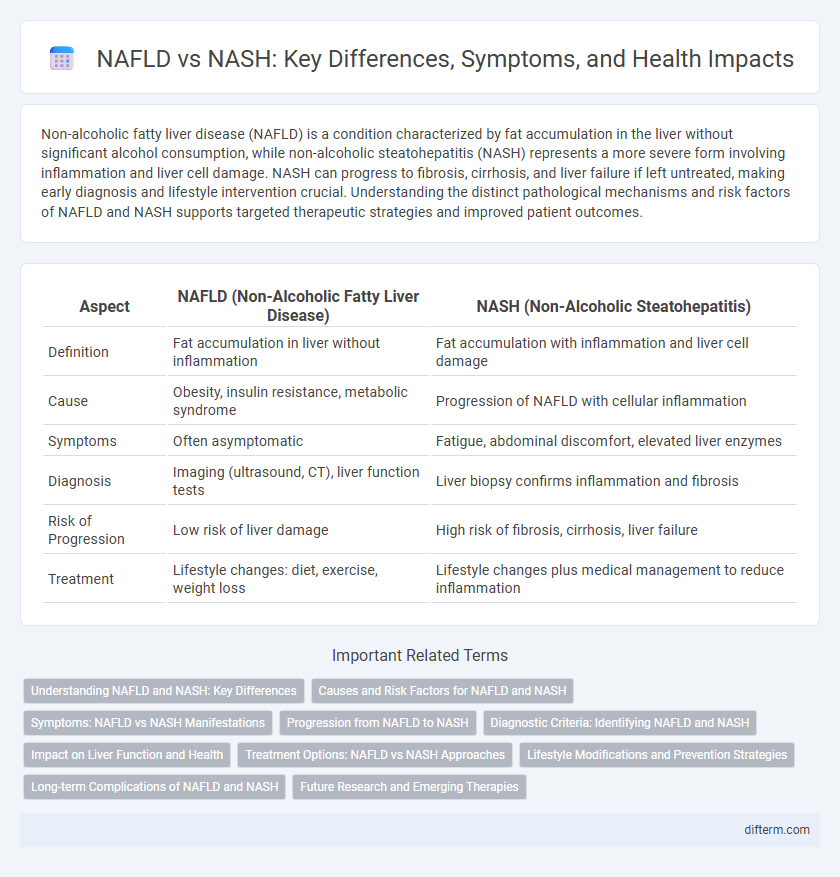Non-alcoholic fatty liver disease (NAFLD) is a condition characterized by fat accumulation in the liver without significant alcohol consumption, while non-alcoholic steatohepatitis (NASH) represents a more severe form involving inflammation and liver cell damage. NASH can progress to fibrosis, cirrhosis, and liver failure if left untreated, making early diagnosis and lifestyle intervention crucial. Understanding the distinct pathological mechanisms and risk factors of NAFLD and NASH supports targeted therapeutic strategies and improved patient outcomes.
Table of Comparison
| Aspect | NAFLD (Non-Alcoholic Fatty Liver Disease) | NASH (Non-Alcoholic Steatohepatitis) |
|---|---|---|
| Definition | Fat accumulation in liver without inflammation | Fat accumulation with inflammation and liver cell damage |
| Cause | Obesity, insulin resistance, metabolic syndrome | Progression of NAFLD with cellular inflammation |
| Symptoms | Often asymptomatic | Fatigue, abdominal discomfort, elevated liver enzymes |
| Diagnosis | Imaging (ultrasound, CT), liver function tests | Liver biopsy confirms inflammation and fibrosis |
| Risk of Progression | Low risk of liver damage | High risk of fibrosis, cirrhosis, liver failure |
| Treatment | Lifestyle changes: diet, exercise, weight loss | Lifestyle changes plus medical management to reduce inflammation |
Understanding NAFLD and NASH: Key Differences
Non-alcoholic fatty liver disease (NAFLD) involves excess fat accumulation in liver cells without significant inflammation, whereas non-alcoholic steatohepatitis (NASH) is a progressive form characterized by liver inflammation and damage. NASH can advance to fibrosis, cirrhosis, or liver cancer, making early diagnosis and intervention critical. Understanding these distinctions aids in targeted treatments and preventive strategies to reduce liver-related morbidity.
Causes and Risk Factors for NAFLD and NASH
Non-alcoholic fatty liver disease (NAFLD) primarily develops due to insulin resistance, obesity, type 2 diabetes, and dyslipidemia, which contribute to hepatic fat accumulation. Non-alcoholic steatohepatitis (NASH), a progressive form of NAFLD, is linked to inflammation and hepatocyte injury driven by oxidative stress, mitochondrial dysfunction, and cytokine release. Genetic predispositions such as PNPLA3 and TM6SF2 variants, along with lifestyle factors like high-fructose diets and sedentary behavior, significantly increase the risk of developing both NAFLD and NASH.
Symptoms: NAFLD vs NASH Manifestations
NAFLD (Non-Alcoholic Fatty Liver Disease) primarily presents with mild or no symptoms, often detected through elevated liver enzymes or incidental imaging findings. In contrast, NASH (Non-Alcoholic Steatohepatitis) manifests with more pronounced symptoms such as fatigue, right upper abdominal discomfort, and signs of liver inflammation or fibrosis on biopsy. Early identification of NASH symptoms is crucial to prevent progression to cirrhosis or liver failure.
Progression from NAFLD to NASH
Non-alcoholic fatty liver disease (NAFLD) can progress to non-alcoholic steatohepatitis (NASH) when simple fat accumulation triggers liver inflammation and cellular injury. Risk factors accelerating this progression include insulin resistance, obesity, type 2 diabetes, and metabolic syndrome, which exacerbate oxidative stress and fibrosis pathways. Understanding these mechanisms is critical for early diagnosis and intervention to prevent advanced liver damage and cirrhosis.
Diagnostic Criteria: Identifying NAFLD and NASH
NAFLD (Non-Alcoholic Fatty Liver Disease) is diagnosed primarily through imaging techniques like ultrasound revealing hepatic steatosis and exclusion of other causes of liver fat accumulation. NASH (Non-Alcoholic Steatohepatitis) requires liver biopsy confirmation showing hepatic steatosis with inflammation and hepatocyte injury, such as ballooning degeneration, alongside elevated liver enzymes ALT and AST. Advanced non-invasive tools, including FibroScan and serum biomarkers like cytokeratin-18, aid in distinguishing NASH severity and fibrosis presence.
Impact on Liver Function and Health
Non-alcoholic fatty liver disease (NAFLD) primarily involves fat accumulation in liver cells, which can impair liver function but often remains reversible with lifestyle changes. Non-alcoholic steatohepatitis (NASH) represents a more severe form of NAFLD, characterized by liver inflammation and cellular damage that significantly increases the risk of fibrosis, cirrhosis, and liver failure. NASH progression leads to compromised liver function, elevating the risk for hepatocellular carcinoma and necessitates more aggressive medical intervention.
Treatment Options: NAFLD vs NASH Approaches
Treatment options for NAFLD primarily emphasize lifestyle modifications such as weight loss, diet changes, and increased physical activity to reduce liver fat and improve insulin sensitivity. NASH treatment often requires pharmacological interventions, including antifibrotic agents and medications like pioglitazone or vitamin E, targeting inflammation and fibrosis progression. Emerging therapies and clinical trials focus on addressing metabolic dysfunction and liver fibrosis specifically in NASH patients.
Lifestyle Modifications and Prevention Strategies
Lifestyle modifications remain the cornerstone for managing Non-Alcoholic Fatty Liver Disease (NAFLD) and preventing progression to Non-Alcoholic Steatohepatitis (NASH), emphasizing weight loss through calorie restriction and increased physical activity. Diets rich in omega-3 fatty acids, antioxidants, and low glycemic index foods improve liver function and reduce hepatic fat accumulation. Avoiding excessive alcohol intake, controlling diabetes, and regular monitoring of liver enzymes support prevention and early intervention strategies.
Long-term Complications of NAFLD and NASH
Non-alcoholic fatty liver disease (NAFLD) can progress to non-alcoholic steatohepatitis (NASH), which significantly increases the risk of liver fibrosis, cirrhosis, and hepatocellular carcinoma. Long-term complications of NASH include accelerated liver damage leading to end-stage liver disease and higher incidence of liver failure requiring transplantation. Both NAFLD and NASH are also associated with increased cardiovascular disease risk, metabolic syndrome, and type 2 diabetes, contributing to overall morbidity and mortality.
Future Research and Emerging Therapies
Future research on Non-Alcoholic Fatty Liver Disease (NAFLD) versus Non-Alcoholic Steatohepatitis (NASH) prioritizes identifying molecular biomarkers for early diagnosis and progression prediction. Emerging therapies target inflammation, fibrosis, and metabolic pathways through agents like FXR agonists, PPAR agonists, and anti-fibrotic drugs showing promise in clinical trials. Precision medicine approaches integrating genetic, epigenetic, and microbiome data aim to tailor treatments and improve outcomes for NAFLD and NASH patients.
NAFLD vs NASH Infographic

 difterm.com
difterm.com